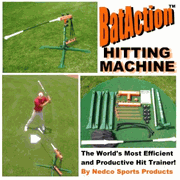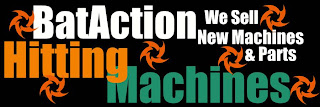
Baseball Instruction - How To Add 50 Points To Your Batting Avg Sitting On The Couch
By Nate Barnett
Don't worry, this is not a promo article on some illegal growth hormone, or some attempt to counter all you've ever learned during your baseball instruction about hard work, practice, and dedication. What I'm about to help reveal to you takes different practice compared to going out to the ballpark every day to work on your skills. It takes more dedication than working out in the cold and rain all winter. It won't transform your game over night; but, if the skill is developed, then I'm confident you will experience a serious boost to your batting average.
The concept is called imagery, or visualization. In non-scientific language, it's simply mental weight-lifting. And the reason many of you have heard of if it is simply because rarely does baseball instruction before the collegiate level emphasize it. I'll give you a taste, but it's up to you to search out more on the topic and really chew on it.
I will be writing as if I was providing some mental baseball instruction to an athlete. If you are a coach or parent reading this, just pick up the concepts should you choose to pass the idea on.
Let's begin.
Take a quick trip back to a game where you struck out with the bases juiced. What did you think about in the field the next inning, or the next time up to bat? Whatever your thoughts were about your performance, good or bad, is called imagery. The more you condition your thinking either positive or negative, the more your body will respond to what is familiar. This is why athletes that are in a hot streak have a bad game and then sometimes slip into a little slide, or a full blown slump. It's not because they suddenly forgot the skill of hitting, their visualization was horrible.
The chance of getting to the next level is determined largely by your ability to control your thoughts and feelings and use them to your advantage. This is especially true if you have a goal of playing professionally. The use of imagery is a must-you'll never get there without it. Ok, enough of the philosophical mumbo jumbo, here is how the concept is applied to your game.
Everybody is always looking for the secret for this or for that in baseball. Well here it is, the raw and uncut version of how to use imagery and take your hitting game to the next level... fast.
First and foremost you must admit to yourself that each year the skill level of the players in your league increases. Some are still figuring things out mechanically, but most have a general idea by now. This simply means that there is a good chance that you're not "the man" in your league, let alone your team. If you are, "the man" and you're not using visualization tactics, you'll have some serious competition soon.
Let me put you in the right frame of reference with an illustration we can all relate to, unfortunately. You're up to bat, it's a 2-2 count, and the guy has a nasty curve ball you haven't seen in a while. A quick thought runs through your mind and you wonder if you might see it this pitch. He winds, you ready yourself, the pitch is released, and sure enough it's the big hammer. Strike three looking. You trudge slowly back to the dugout with your head down, teeth clenched in frustration as you grab your spot on the bench.
If you haven't experienced the above scenario yet, you haven't been playing long enough. It will happen a couple dozen times to you. But, the real problem is not the strikeout; the best in the game strike out all the time. No amount of drill training or baseball instruction can prevent it.
The issue is your automatic instant replay system in your head is working overtime for the rest of the inning. It's playing back your strikeout mentally over and over and over for you to think about. Your imagery you are giving yourself stinks. It's programming your body to react the same way the next time you find yourself in a similar situation. The cool part is, you can fully manage your instant replay system with some practice.
If you want to be sure what images are being played through your instant replay mechanism, you have to make sure you've tuned it to the correct mental channel. What do you do when there is a show on television you don't want to watch? Turn the channel. The same applies to your mind in baseball.
You must change your station after you experience a negative result as an athlete. Here is the meat of this concept. If you've spaced out until now, this is the paragraph you'll want to understand. I'll use the previous example of the strikeout looking above. I use this image because it's often an opportune time for your instant replay to run haywire quickly. The key after the strikeout is to take a minute once back in the dugout, or before the next inning starts out in the field, and change your mental channel. Most athletes will replay the strikeout over and over again, getting more frustrated in the process. It's what feels normal, and you're mind will do this automatically. Instead, play the at bat over again in your mind, but this time with a positive ending. Maybe it's a base hit through the hole, maybe it's a double off the wall in deep left, or it could possibly be a bunt base hit. Repeat the at bat multiple times in a row and then give it a rest and refocus on your current task on defense. The next time you're on deck, play the positive result instant replay series again and you'll be fully prepared for your following at bat.
What if you can't control your thinking?
Negative thoughts running through your mind takes up space in your head used for concentration and relaxation. If your main focus is on how poorly you performed in your last at bat then you cannot use that energy for anything productive at that moment or for moments afterwards. It takes time to change your energy and focus. And if you allow your mental replay system to switch channels frequently, you'll soon find yourself not relaxed when you need to be.
What if you can manage your replay efficiently? If you've ever experienced being in the "zone" this is what it feels like to have your thoughts fully under control. Your mind will have 100% focus and concentration on your task at hand without any room for scattered thoughts about what you should have done.
The only catch to this skill development is that it takes time. Just like hitting a baseball takes time and practice to master, so does mental conditioning. But once you get it, the results will be spectacular.
About the Author
Nate Barnett is owner of BMI Baseball http://bmibaseball.com and is based out of Washington State. His expertise is in the area of hitting, pitching, and mental training. Coach Barnett's passion is working with youth in helping expand their vision for their baseball future. After finishing a professional career in the Seattle Mariners Organization, Nate pursued his coaching and motivational training career. His instructional blog is located at http://bmibaseball.com/blog
His new FREE ebook, Toxic Baseball: Are you polluting your game? can be found on the main BMI Baseball website.
Hitting 101, an ebook on complete hitting mechanics will be released by June 1st, 2008. Features include numerous illustrations, video clips, and a special offer to discuss your hitting questions over live on the phone strategy sessions.
Check Out These Recommended Baseball Coaching Websites:
AmericanBaseballDirectory.comBaseball Coaching JournalBaseballCoachingDigest.comBattingCageBuilder.comBaseball Training Equipment Sites:
BatAction.comHurricaneMachine.comAdvancedSkillsTee.comQuickSwingTrainer.comHandsBackHitter.comStayBackTee.comBattingCagesDirect.comOnline Baseball Stores:
Baseball2u.comBaseball DealzCoachesBest.comBaseball Blogs for Coaches - Free Training Tips, Coaching Articles and More
Check out these recommended blogs for baseball coaches.
Baseball Coaching and Training Equipment BlogThe Hurricane Hitting Machine - Derek Jeter Series - Training and Coaching Blog BatAction Machine Baseball Training and Coaching Blog Batting Cage Information and Know-how: Buying, Building and Using Your New Batting Cage TeeBall Coaching Drills, Tips and Other Information Baseball Training Homework For Youth Players Blog Baseball Parents Guide To Helping a Player Improve Blog Baseball Coaching, Training and Instruction


























